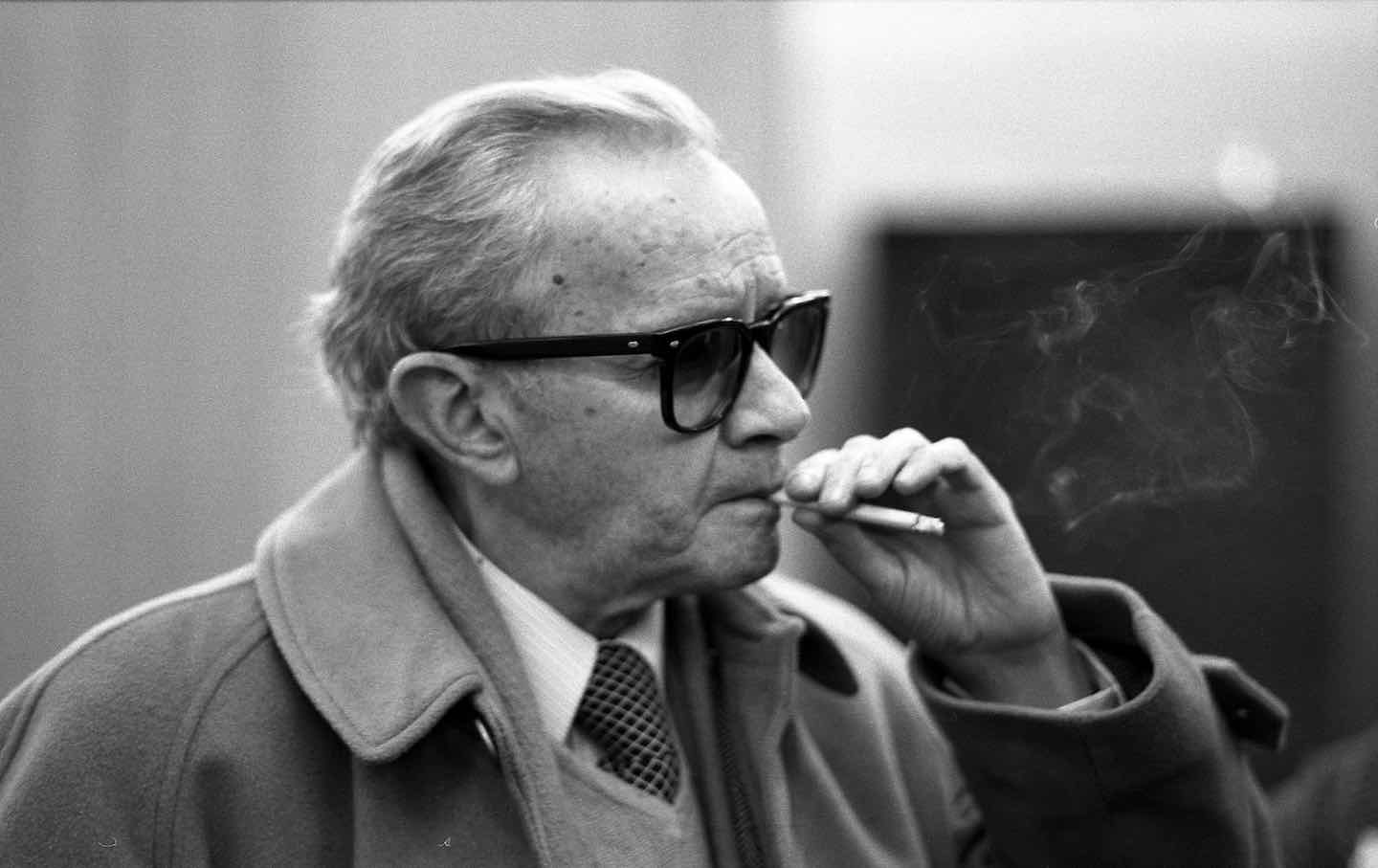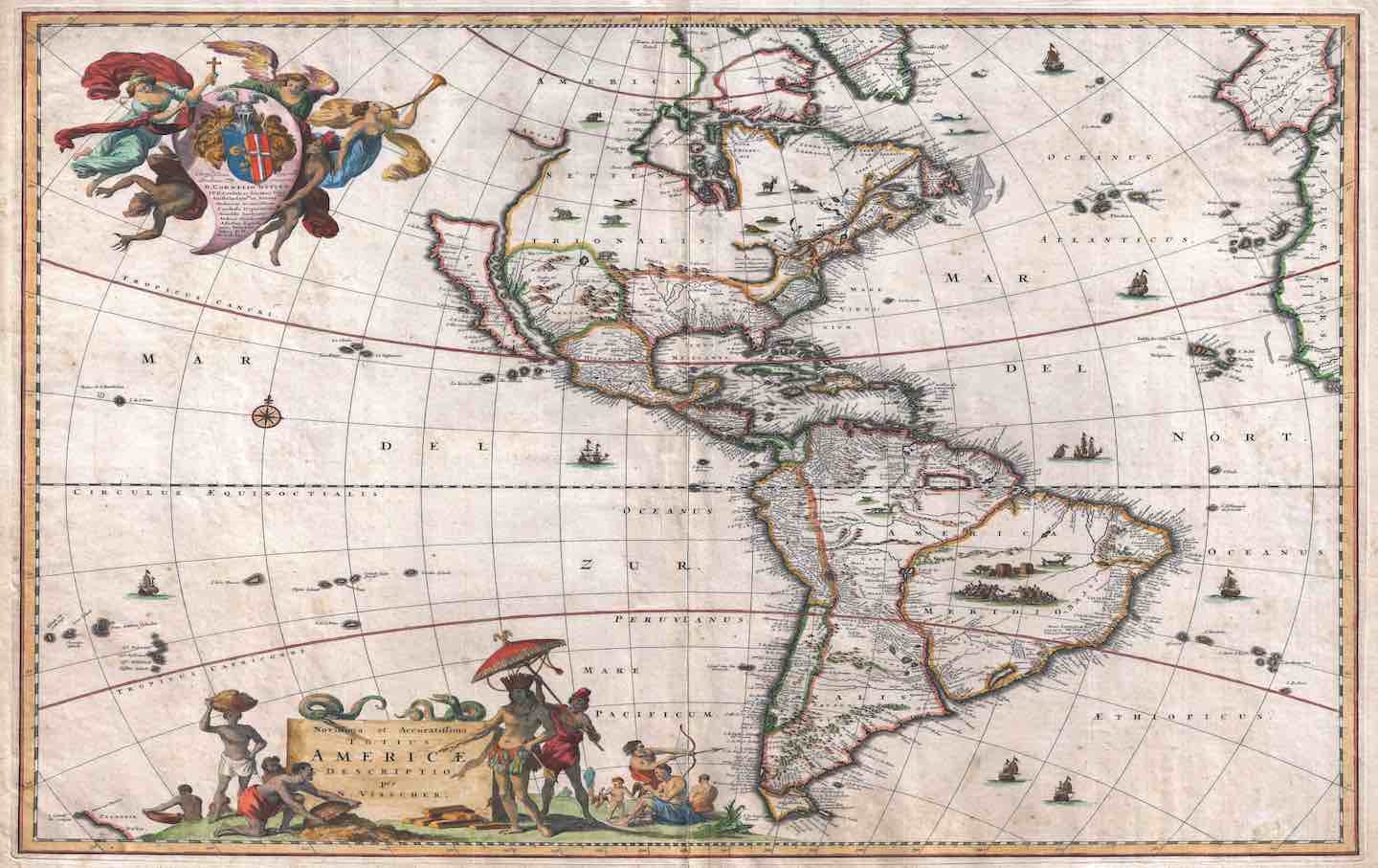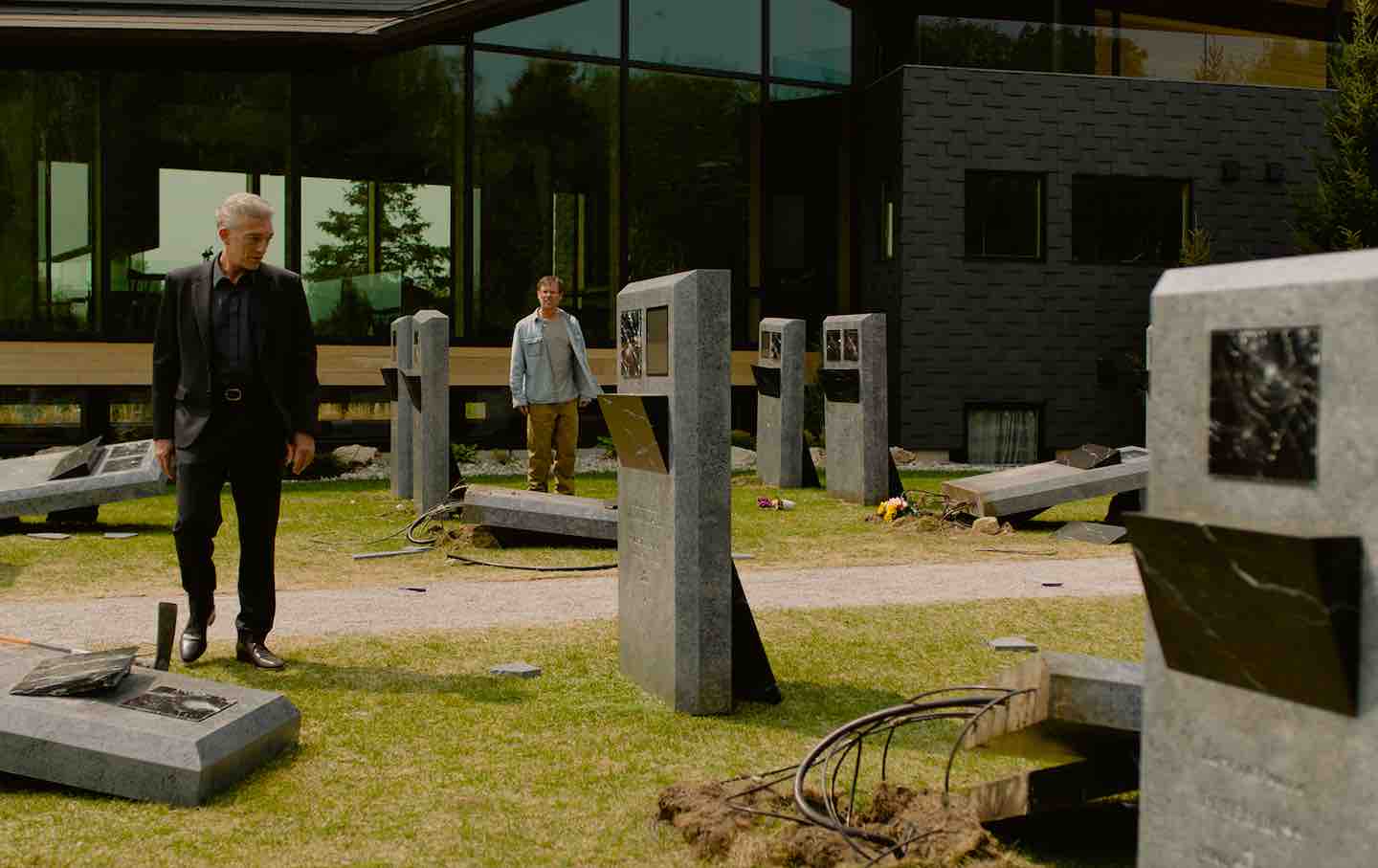Notes From a Dead House
Juan Rulfo’s Pedro Páramo.
Juan Rulfo’s Revolution in Mexican Fiction
In his 1955 masterpiece Pedro Páramo, he gave the bloody history of his country—between the rich and poor, landed and landless—mythic dimension.

Juan Rulfo, 1985.
(Photo by Schiffer-Fuchs / ullstein bild via Getty Images)A man stands alone in a barren landscape. He wears a poncho, a chain of beads, and a sombrero that darkens his face. Having lingered on him for a few moments, the camera pans right, as if it’s more interested in the sand and rocks. But the man follows suit and returns to the center of the frame. Now the camera pans back left, pursued by the man, who again confronts the viewer. “You will say that I am stubborn,” the narrator begins. “That it is folly to lament one’s luck, and more so in this stupefying, benumbed land.” The scene cuts to other men in the desert, crouched against small ridges. “The truth is that it’s hard to adjust to hunger,” the narrator goes on. “The only certain thing is that everyone here is half-dead, and without a place to drop over.”
Books in review
Pedro Páramo
Buy this bookThis is a sequence from The Secret Formula (1965), an experimental film made by the director Rubén Gámez. The movie strings together a series of vignettes—priests ride a merry-go-round, a vaquero lassoes a businessman on a city street—shows a country torn between urban prosperity and agrarian poverty. All along, the narrator speaks for those left behind by the state: “Not even burning on coals will our luck catch fire…. Someone has to hear us, even though our cries might annoy or upset them.”
Juan Rulfo wrote The Secret Formula’s narration. The film’s images of rural desolation are clearly inspired by his fictions. His slim body of work—one novel, one novella, and a collection of stories—is entirely set in the Mexican countryside: more specifically in la tierra caliente, a strip of hot, dry land in interior Jalisco. Composed in the 1950s, these narratives look back to the early 20th century, when a feudal society organized around haciendas was shaken during the Mexican Revolution and dismantled in the land reforms that followed. The son of hacendados, Rulfo came of age amid the protracted conflict, in which members of his family were killed by guerrillas. Yet, as a writer, he adopted the perspective of the peasants that his family held in contempt.
Rulfo’s la tierra caliente lies near the heart of any map of Mexican literature. He is best known for Pedro Páramo (1955)—a dense, stark, allegorical novel about a cacique, or feudal tyrant, who reigns over a small town. Over nearly 70 years, the book has won many famous admirers—Jorge Luis Borges, Susan Sontag, Italo Calvino—and has been admired for a variety of reasons. Early Mexican critics wanted to believe it evoked the worldview of the laboring classes: Rulfo “has given himself entirely over to the voices of the people,” Elena Poniatowska wrote. Later, novelists associated with “El Boom” studied its structuring of time, which is circular rather than linear, grounded in myth rather than history. No stranger to charming hyperbole, Gabriel García Márquez claimed to be able to “recite the entire book front to back and vice versa without a single appreciable error.”
Above all, Spanish readers have responded to its language. Rulfo had an “uncanny ability to give a lyrical majesty and distinct rhythm to the terse colloquial speech of the poorest Mexican peasants,” Ariel Dorfman has argued. “The English versions of his work rarely preserve the magic of the Spanish original.” This is probably why Pedro Páramo has not found an Anglophone readership. Douglas J. Weatherford’s new translation is more fluid and accurate than Margaret Sayers Peden’s wooden and error-strewn edition from 1994. It is another chance to discover the emblematic Mexican novel of the 20th century.
Rulfo was born in 1917 in San Gabriel, a town in Jalisco. His family belonged to the rural aristocracy; both sets of grandparents were hacendados, and his other relatives included bureaucrats, lawyers, and politicians. They were terrorized during the Mexican Revolution (1910–20) by peasant revolutionaries who burned down the parental property four times, killed Rulfo’s uncle, and strung his maternal grandfather up by his thumbs in public. Life was hardly easier in the aftermath. In 1923, Rulfo’s father was shot by a rancher in a dispute over grazing rights; the murder is dramatized in the story “Tell Them Not to Kill Me.” Rulfo’s grandfather drank himself to death a year later. When his mother mysteriously passed away, the boy was sent to an orphanage. Eduardo Galeano put the pieces together:
San Gabriel de Jalisco: A Child Looks On—the mother covers his eyes so he cannot see his grandfather hanging by the feet. And then the mother’s hands prevent his seeing his father’s body riddled by the bandits’ bullets, or his uncle’s twisting in the wind over there on the telegraph posts…. Now the mother too has died, or perhaps has just tired of defending her child’s eyes. Sitting on the stone fence that snakes over the slopes, Juan Rulfo contemplates his harsh land with a naked eye.
Rulfo seems to have harbored literary ambitions from a young age. His earliest reading experiences date to the Cristero War (1926–29), a conflict between fanatical Christian peasants and the anticlerical revolutionary forces: At the time, a militant priest took refuge on the family estate, bringing along a collection of profane literature that included Alexander Dumas and Victor Hugo. At school, Rulfo excelled in Mexican colonial history, which remained an abiding interest. Later, amid brief stints at the university and a sinecure at the Ministry of Migration, he immersed himself in the literature of the day and was drawn to rural modernism: Jean Giono, William Faulkner, and, above all, the Nordic novelists from the turn of the century, such as Knut Hamsun, Selma Lagerlöf, and Haldor Laxness, who depicted, in a lyrical and modern style, the cruel and backward social world of the Northern European backwaters. That mixture of old and new would become a distinctive feature of Rulfo’s work.
Latin American fiction in the 1940s was dominated by novelas de la tierra, or novels of the land. The genre had arisen a few decades earlier, as uneven development swept over South and Central America. Written by the educated elite, who had grown up in or moved to urban centers, these narratives generally unfolded in rural areas, among illiterate peasants and Indigenous communities. The gap between those two worldviews was a source of dramatic tension. For instance, in his seminal novel of the Mexican Revolution, The Underdogs (1924), Mariano Azuela includes the figure of an outside observer, the urbane medic Dr. Cervantes, who travels with Pancho Villa’s guerrilla fighters but is ever frustrated in his attempts to make sense of their motivations. Similarly, at the level of language, novelists of the land played their narratorial stand-ins’ refined address against the rustic accents of secondary figures. “They came up with a dual system in their writing, with the learned literary language of modernism alternating with the dialectal register of their mainly rural characters,” the Uruguayan critic Angel Rama noted in his 1982 study, Narrative Transculturation in Latin America.
Part of Rulfo’s achievement was to bring together the two wings of this “dual system.” His first book, The Plain in Flames (1953), collects 17 brief stories—few are longer than seven pages—about the poverty-stricken villages and towns in la tierra caliente. These are either narrated in the first person or framed as dialogues or monologues. In the absence of a mediating figure, the reader hears directly from the rural men and (a few) women swept up in conflict: Three pieces address the Mexican Revolution, another three feature combatants in the Cristero War, and the rest turn on squabbles over money, land, and romance.
The peasant sensibility that emerges is remarkably cohesive. Rulfo’s characters are forlorn, taciturn, and religious; intellectually limited, spiritually anguished, and often violent—12 of the 17 protagonists are murderers. They scrape by in an agrarian world untouched by industry, where feudal hierarchies have withstood the revolutionary upheaval. Relations between men and women are governed by an unforgiving Catholic patriarchy. The narrator of “It’s Because We’re So Poor” is tormented by the disappearance of the family cow, which was supposed to be the dowry for his 12-year-old sister, to ensure that she did not “run away to become a whore the way my two older sisters had.” Politics is despairingly satirized, as in the title story, narrated by a revolutionary who takes a childish glee in arson: “It all looked very beautiful to see the fire marching along the pastures, to see almost the entire Plain turned into a burning coal in that combustion, with the smoke undulating up above; the smoke smelling like cane and honey, because the fire had also reached the cane fields.”
Perhaps the collection’s best-known story is “Luvina,” in which a teacher recalls his posting in a desolate hilltop town where an aging community simply awaits death. “San Juan Luvina. The name sounded celestial to me,” he says. “But it’s Purgatory. A moribund place where even the dogs have died and there’s not even anyone to bark at the silence.” In Death and the Idea of Mexico (2005), the Mexican anthropologist Claudio Lomnitz connects “Luvina” to a morbid fascination with the afterlife that overcame the mid-century Mexican intelligentsia. He interprets this “death cult” as a reaction to the state’s failure to fulfill the dreams of the revolution, leaving the country in a purgatorial state, unwilling to shed its feudal past and unable to achieve economic development. “Mexico is one of those countries that have had to recognize serious limitations to concerted collective action,” Lomnitz writes. “It was this awareness of an only very tenuously shared sense of a future that led intellectuals…to elevate Death to the status of a national sign.” That metaphor is made literal in Rulfo’s next book, a novel set in the town of the living dead.
Rulfo wrote Pedro Páramo over the course of four months in 1954. His original draft, over 300 pages, was finally cut down to 129. The novel tells two interrelated stories: The first is about Juan Preciado, who after the death of his mother, Dolores, has set out for the town of Comala in search of his father, Pedro Páramo, a man whom he has never known. The second story is that of Comala, where Preciado arrives to discover that Páramo has passed away—as has everyone else. The realization dawns on him gradually, as he meets a string of aged women who take him in, pass on bits of history and gossip, and then disappear, only to be revealed as apparitions. “The town is full of echoes,” one tells him. “It’s as if they were trapped in the gaps of the walls or beneath the cobblestones.”
Popular
“swipe left below to view more authors”Swipe →The novel is intricately constructed. Broken into brief sections—most are between two and three pages—its narrative moves freely between Preciado’s first-person account, the tales ghosts tell him, and past episodes from the lives of various denizens of Comala, recounted in the third person. Among the characters who recur are the corrupt, conflicted priest, Father Rentería; the cacique’s mentally unstable last wife, Susana San Juan; and Páramo himself. First seen as a lonely child, he is transformed into a despot when his hacendado father is killed—the bullet was intended for someone else—at a wedding. From that point on, Páramo embarks on a reign of terror, taking over the surrounding lands and fathering countless bastards through rape, one of whom eventually kills him.
Páramo is the avatar of a figure who looms large in the Mexican imagination: the conquistador who inaugurated the nation through rape and pillage. Carlos Fuentes, one of Rulfo’s earliest advocates, made this connection: He wrote that Páramo should be seen as “the bearer of the myth, the father of the tribe, the cursed ancestor, the founder of the New World, the raper of mothers, the father of every last one of los hijos de la chingada [sons of rape].” Crucially, Páramo’s mythic dimensions are firmly grounded in psychological details. By turns ruthless and sentimental (about Susana), impulsive and calculating, he is driven by ferocious appetites—for power and sex—as well as his messianic self-conception as Comala’s sovereign. “What laws?” Páramo declares at one point. “From now on, we’ll be the ones making the laws.” By contrast, his son Preciado remains a cipher. Rulfo intends to present him as the archetypal mestizo confronting a fraught patrimony, but it’s hard for Preciado to come into his own in a deserted town that saps his strength: “My body seemed to be floating…anyone could’ve played with it as if it were a bundle of rags.” Perhaps that’s why he’s killed off midway through. “The weather up there must be changing,” Preciado says, from inside the grave.
Thereafter, the novel is largely given over to an account of Comala’s destruction. Rather than charting its rise and fall chronologically, Rulfo jumps backward and forward, withholding key details until late in the book, narrating most scenes in the present tense. This approach allows him to prolong the dramatic tension and to make startling juxtapositions. For instance, the murder of Páramo’s teenage son (and Preciado’s brother) Miguel—himself a rapist and killer—is immediately followed by the scene of his birth, which the cacique learns about when Father Rentería brings him the infant, whose mother has died. As the time lines proliferate, the novel seems to rise to a mythic plane where all time coexists in an eternal present. Rulfo hints at this idea by repeating the same exchange of dialogue nine pages apart. “You ever hear a dead man moaning?” a shade asks Preciado. “All the better,” she continues, when he replies no. Episodes from Páramo’s and Father Rentería’s lives follow, after which the earlier conversation resumes: “All the better, son, all the better.”
Rulfo conjures this world in an idiom that is spare and pointed, hushed and musical, formal and plainspoken. He builds his ethereal scenes up from sensory details, and he stands at a kind of middle distance from characters, combining an old-fashioned storyteller’s reticence about human motivation with a modern novelist’s psychological acuity. The translator’s challenge is to balance these contrasts in English. Overplay one aspect of Rulfo’s style at the expense of another and it all falls apart.
On the whole, Douglas J. Weatherford avoids the pitfalls of folklore and oracularity that Margaret Sayers Peden frequently succumbed to. Yet his version ultimately does not quite come to life either. He fastidiously replicates Rulfo’s use of the subjunctive mood, which reads unobtrusively in Spanish but is distracting in English. When Father Rentería’s niece Anita recounts being raped by Miguel Páramo, Weatherford’s translation reads: “I even stopped thinking so maybe I’d already be dead before he took my life…it felt as if I no longer existed.” The constructions here—“so maybe I’d already”; “as if I no longer”—turn physical violation into a metaphysical drama. Weatherford also gets tied up in knots imitating Rulfo’s syntax, as when Preciado vows at his mother’s deathbed to visit Comala: “That’s why I couldn’t refuse her, and after agreeing so many times I just kept at it until I had to struggle to free my hands from hers.” His dialogue is unconvincingly colloquial: “He’s gonna throw you quite the party”; “Why don’t you leave me be and let me rest?”
In sum, the reader has the unpleasant sense of missing something crucial from the original. Which prompts a broader question: Why are the existing translations of Rulfo’s books second-rate? His frequently intractable prose sits deep within the Spanish language. (This is evident from the various names in Pedro Páramo: “Comala” derives from comal, which is a pan used for warming tortillas; páramo is a bleak plateau or wasteland; and so forth.) Paradoxically, then, his style might have to be reinvented in English rather than simply replicated. A project of this kind is beyond Peden, Weatherford, and Ilan Stavans (who translated The Plain in Flames with help from Harold Augenbraum), who all lack a true feeling for the English language. A talented poet or novelist is more likely to bring Rulfo to an Anglophone audience, which has been denied his gifts for too long.
Though the sales were initially poor, Pedro Páramo was received by critics as a modern classic. In 1956, Rulfo wrote a novella, The Golden Cockerel, a gripping if more straightforward tale about a village simpleton, Dionisio Pinzón, whose fortunes turn when he acquires a prize fighting cock: “Little by little, his very nature was becoming something else through his exposure to the violent sport of cockfighting, as if the thick, reddish liquid coming from those dying animals had turned him to stone, transforming him into a cold and calculating man, sure and confident in the path of his destiny.” Other than that, Rulfo did not publish anything else, even as his fame inexorably grew.
The feudal world that Rulfo depicted disappeared long ago, but his fiction has not dated: Mexico has yet to escape the clutches of underdevelopment, machismo, and criminality. Ultimately, his interests were ethical and not political. The overarching concern of his oeuvre is what it means to live in a society where violence has been normalized. His narrative tone—mournful but unsentimental, distressed but unflinching, critical but nonjudgmental—offers one answer to that question. Another is given by a priest in Pedro Páramo, who refuses to grant absolution when Father Rentería begs forgiveness for turning a blind eye to the cacique: “It’s not enough to be good. Sin is wrong. And to get rid of it, you have to be tough, even ruthless.”
Hold the powerful to account by supporting The Nation
The chaos and cruelty of the Trump administration reaches new lows each week.
Trump’s catastrophic “Liberation Day” has wreaked havoc on the world economy and set up yet another constitutional crisis at home. Plainclothes officers continue to abduct university students off the streets. So-called “enemy aliens” are flown abroad to a mega prison against the orders of the courts. And Signalgate promises to be the first of many incompetence scandals that expose the brutal violence at the core of the American empire.
At a time when elite universities, powerful law firms, and influential media outlets are capitulating to Trump’s intimidation, The Nation is more determined than ever before to hold the powerful to account.
In just the last month, we’ve published reporting on how Trump outsources his mass deportation agenda to other countries, exposed the administration’s appeal to obscure laws to carry out its repressive agenda, and amplified the voices of brave student activists targeted by universities.
We also continue to tell the stories of those who fight back against Trump and Musk, whether on the streets in growing protest movements, in town halls across the country, or in critical state elections—like Wisconsin’s recent state Supreme Court race—that provide a model for resisting Trumpism and prove that Musk can’t buy our democracy.
This is the journalism that matters in 2025. But we can’t do this without you. As a reader-supported publication, we rely on the support of generous donors. Please, help make our essential independent journalism possible with a donation today.
In solidarity,
The Editors
The Nation








